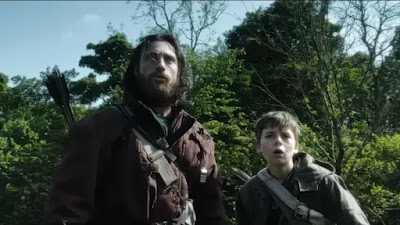
Images courtesy of Sony Pictures
Several years ago, I took a trip to Italy and visited the Capuchin Crypt in Rome. Between 1500 and 1870, it was decorated with the skeletal remains of over 4000 deceased friars, and their bones are arranged into elaborate artistic displays. When I entered the small rooms of the crypt, I was met with a blast of cool, slightly musty air, a welcome respite from the hot summer day outside, but a chilling reminder of the icy grip that death has on all our physical forms. One would imagine that seeing a chandelier made from human bones would be macabre, but it had the opposite effect; there was a quiet power and a comforting notion that even in death, we could eternally contribute to the beauty of the living.
After making my way through the crypt, I was met with a gift shop at the end, where I could buy commemorative magnets and skull-themed bottle openers, a strange shift in tone from the reverence shown towards the dead in the crypt proper. 28 Years Later (2025) is similarly constructed as a coming-of-age story that tenderly explores Memento Mori and offers a sardonic and occasionally cynical take on the apocalypse and its meaning to modern audiences.
28 Years Later begins with a recap, suggesting that following the events of the first two films, the infection was contained in mainland Europe but had spread significantly throughout the British Isles. As a result, the islands were placed under an indefinite quarantine from the rest of the world. Now, almost three decades have passed, and the inhabitants of the island have adapted to living in the shadow of the Rage Virus. A small, fortified community has formed, and its members live a simple life governed by their own set of rules. Among them is Spike (Alfie Williams), a young boy on the brink of puberty, who lives with his father, Jamie (Aaron Taylor-Johnson), and his gravely ill mother, Isla (Jodie Comer).
The first half of the film features a distinctly folk horror and arthouse aesthetic, as it explores the daily lives of the islanders and the ways they have adapted to living alongside the infected. Spike has never left the island and is scared of the prospects, but his father is insistent that he participate in a ritual that requires him to go to the mainland to experience what it's like to encounter and kill the rage folk. After years of being infected by the virus, those afflicted have devolved into an animal state, grouping together into "herds" and even being governed by "alpha" variants that are smarter and stronger.
Director Danny Boyle, writer Alex Garland, and cinematographer Anthony Dod Mantle have all reunited from the first film, and it feels very similar to the tone of 28 Days Later. Boyle's assertive and snappy editing propels the narrative along at a rapid pace, and he isn't afraid to insert strong political allegory, often drawing on historical wartime footage and imagery. It's not a huge jump to connect the symbology of Europe isolating a rage-filled country and the ideology of Brexit. He makes some bold stylistic choices that might alienate some viewers, one of which is the use of a videogame-inspired "kill cam" employed whenever characters shoot the infected.
Garland is always preoccupied with humanity's failings, and his nihilistic worldview hangs over the story like a shroud. However, later in the film, it softens with a poignant philosophical aside (with a touching and delicate performance from Ralph Fiennes) about the inevitability of death and the need to accept it. The choice to shoot the film with iPhones gives the same vibe as the DV camera in the first movie, but the change of setting to forests and countryside imbues the setting with a naturalistic beauty. Occasionally, the visuals veer into fantastical soft sci-fi territory, which can feel jarring in a good way.
Alfie Williams' performance is the heart and soul of the story, as we watch him slowly become the man he is meant to be. His father means well, but he has a limited understanding of the definition of masculinity, which is often tied to the concept of the survival of the fittest. This is most apparent in his treatment of Isla, whom he has all but abandoned in her illness, as her weakness repulses him on a deeper level. As an aside, men leaving women when they are chronically ill is common enough that when women receive a dire diagnosis from a doctor, part of the briefing is the warning that their partner might leave them. Spike rejects this notion, and his love for his mother is the light that illuminates the center of the film.
Most "made too late" sequels have the distinct stench of cashing in, but 28 Years Later feels like a film that was made by an artist inspired to revisit his work and expand on it with the life experience and knowledge he has gained over the years. It's not perfect, and the abrupt tone-shifting might turn some people off, but it's a bold and uncompromising piece of work that isn't hampered by playing into safe sequel tropes.
--Michelle Kisner



